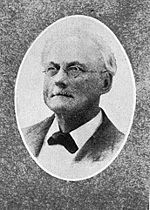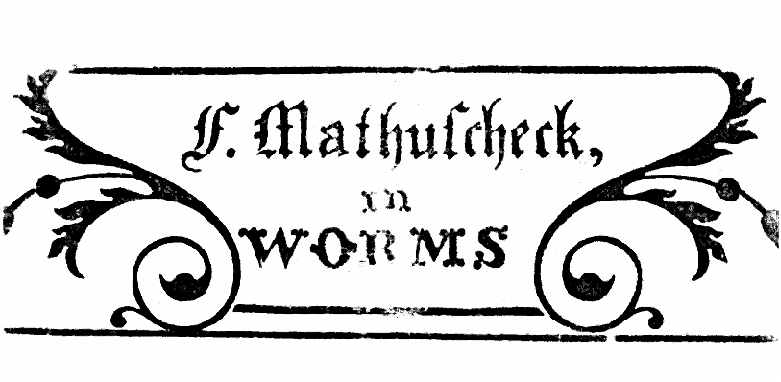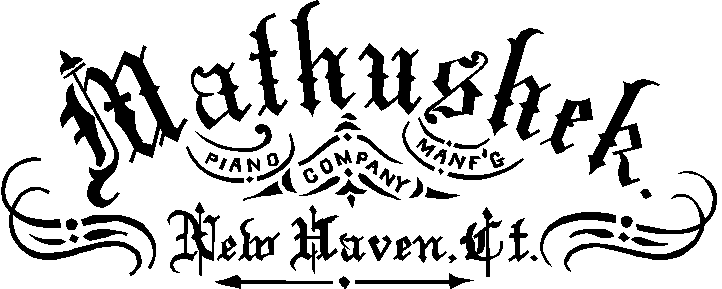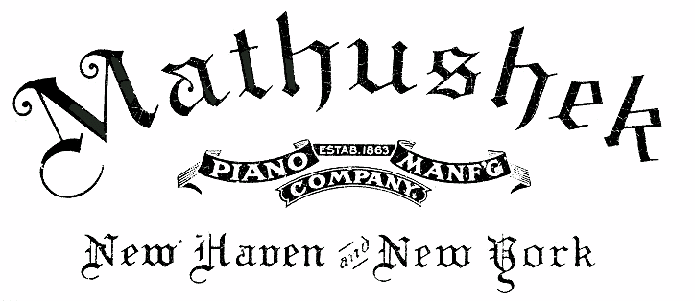
Frederick Mathushek
Encyclopedia

Piano
The piano is a musical instrument played by means of a keyboard. It is one of the most popular instruments in the world. Widely used in classical and jazz music for solo performances, ensemble use, chamber music and accompaniment, the piano is also very popular as an aid to composing and rehearsal...
maker working in Worms
Worms, Germany
Worms is a city in Rhineland-Palatinate, Germany, on the Rhine River. At the end of 2004, it had 85,829 inhabitants.Established by the Celts, who called it Borbetomagus, Worms today remains embattled with the cities Trier and Cologne over the title of "Oldest City in Germany." Worms is the only...
, in Rhineland
Rhineland
Historically, the Rhinelands refers to a loosely-defined region embracing the land on either bank of the River Rhine in central Europe....
, Germany
Germany
Germany , officially the Federal Republic of Germany , is a federal parliamentary republic in Europe. The country consists of 16 states while the capital and largest city is Berlin. Germany covers an area of 357,021 km2 and has a largely temperate seasonal climate...
and in the United States
United States
The United States of America is a federal constitutional republic comprising fifty states and a federal district...
at New York City
New York City
New York is the most populous city in the United States and the center of the New York Metropolitan Area, one of the most populous metropolitan areas in the world. New York exerts a significant impact upon global commerce, finance, media, art, fashion, research, technology, education, and...
and New Haven, Connecticut
New Haven, Connecticut
New Haven is the second-largest city in Connecticut and the sixth-largest in New England. According to the 2010 Census, New Haven's population increased by 5.0% between 2000 and 2010, a rate higher than that of the State of Connecticut, and higher than that of the state's five largest cities, and...
during the second half of the nineteenth century. His name continued to be used by several different piano manufacturers through the 1950s, and was filed independently as a trademark for musical instruments in 2005 and 2008.
Worms

Mannheim
Mannheim is a city in southwestern Germany. With about 315,000 inhabitants, Mannheim is the second-largest city in the Bundesland of Baden-Württemberg, following the capital city of Stuttgart....
, in Baden
Baden
Baden is a historical state on the east bank of the Rhine in the southwest of Germany, now the western part of the Baden-Württemberg of Germany....
, June 9, 1814, and apprenticed with a pianomaker of that city until the age of 17, when he travelled visiting piano making facilities in Germany, Austria
Austria
Austria , officially the Republic of Austria , is a landlocked country of roughly 8.4 million people in Central Europe. It is bordered by the Czech Republic and Germany to the north, Slovakia and Hungary to the east, Slovenia and Italy to the south, and Switzerland and Liechtenstein to the...
, Russia
Russia
Russia or , officially known as both Russia and the Russian Federation , is a country in northern Eurasia. It is a federal semi-presidential republic, comprising 83 federal subjects...
, and eventually Paris
Paris
Paris is the capital and largest city in France, situated on the river Seine, in northern France, at the heart of the Île-de-France region...
, before establishing his own workshop in Worms, where he built pianos influenced by those he had seen in the factory of Jean-Henri Pape
Jean-Henri Pape
Jean-Henri Pape was a distinguished French piano maker in the early 19th century.Pape was born in Sarstedt in 1787. He arrived in Paris in 1811 and secured employment with Pleyel, whose piano workshops he directed for several years. In 1815, he established his own manufacture of pianos, and almost...
.
New York, 1850s
In 1849 Mathushek emigrated to New York (after holding a prominent position with Erard in LondonLondon
London is the capital city of :England and the :United Kingdom, the largest metropolitan area in the United Kingdom, and the largest urban zone in the European Union by most measures. Located on the River Thames, London has been a major settlement for two millennia, its history going back to its...
according to his obituary), and worked for John B. Dunham, who was one of the first piano manufacturers to introduce overstringing in America several years earlier. Alfred Dolge wrote Mathushek perfected a simplified press for applying felt covering to piano hammers in 1850, and in 1851 he patented a method for overstringing in cast iron frame square piano
Square piano
The square piano is a piano that has horizontal strings arranged diagonally across the rectangular case above the hammers and with the keyboard set in the long side. It is variously attributed to Silbermann and Frederici and was improved by Petzold and Babcock...
s to allow a greater number of strings with larger diameters. The arrangement was intended to improve tone and stability, and it became known as the sweep scale because it distributed the strings much farther apart on the sounding board
Sounding board
A sound board, or soundboard, is the surface of a string instrument that the strings vibrate against, usually via some sort of bridge. The resonant properties of the sound board and the interior of the instrument greatly increase loudness over the string alone.The sound board operates by the...
than more conventional methods of stringing.
Mathushek started his own workshop in New York in 1852, and that year listed his address at 118 East 21st street, but piano historians Daniel Spillane and Alfred Dolge wrote that by 1857 he had been engaged to bring some of Spencer B. Driggs' designs to practical form. Driggs had moved to New York from Detroit, Michigan
Detroit, Michigan
Detroit is the major city among the primary cultural, financial, and transportation centers in the Metro Detroit area, a region of 5.2 million people. As the seat of Wayne County, the city of Detroit is the largest city in the U.S. state of Michigan and serves as a major port on the Detroit River...
in 1856 after patenting his linguine repeating attachment, and campaigned to improve the piano through a series of patents he concentrated around the construction of violins. The identifying feature was the use of two un-barred sounding boards, one of which was meant to form the bottom of the instrument instead of the usual heavy wooden base or frame, and they were intended to be bent into arches to increase their stiffness and coupled using a sound post
Sound post
In a string instrument, the sound post is a small dowel inside the instrument under the treble end of the bridge, spanning the space between the top and back plates and held in place by friction...
.
By late 1859 Mathushek was associated with Wellington Wells, and coassigned him patents for a repetition action and grand pianos. These overstrung pianos had closely spaced strings arranged at sharp angles to the keyboard following the same principles as the bichord parlor grands introduced in America by Chickering and Sons
Chickering and Sons
Chickering and Sons was an American piano manufacturer located in Boston, known for producing award-winning instruments of superb quality and design. The company was founded in 1823 by Jonas Chickering and James Stewart, but the partnership dissolved four years later...
in the early 1850s (now known as cocked hats) as well as spinet
Spinet
A spinet is a smaller type of harpsichord or other keyboard instrument, such as a piano or organ.-Spinets as harpsichords:While the term spinet is used to designate a harpsichord, typically what is meant is the bentside spinet, described in this section...
harpsichords, and were also meant to have string clamp bridge agraffes deflecting the strings in order to draw the concave sounding board upwards.
Mathushek & Kuhner
In 1863 Mathushek was a member of Mathushek & Kühner, a copartnership with Leopold Kuhner, and they were awarded a bronze medal for a "piano of new and elegant shape" at the American Institute Fair that year. The firm was listed at 34 Second Avenue in 1864 and 10 Second Avenue by 1866.Mathushek Piano Manufacturing Company

New Haven, Connecticut
New Haven is the second-largest city in Connecticut and the sixth-largest in New England. According to the 2010 Census, New Haven's population increased by 5.0% between 2000 and 2010, a rate higher than that of the State of Connecticut, and higher than that of the state's five largest cities, and...
, convinced Mathushek move from New York to superintend a piano manufacturing company newly organized as the Mathushek Piano Manufacturing Company. Steinert and his investors soon backed out of the concern, and ownership of the company passed to Henry S. Parmelee
Henry S. Parmalee
Henry S. Parmalee, a piano maker from New Haven, Connecticut, invented a fire sprinkler system in 1874 to protect his piano factory. While other patents for fire sprinklers predated Parmalee's work, he is credited with the first practical automated sprinkler head.His piano company The Mathushek...
, whose relative Spencer T. Parmelee of New Haven had patented the tuning pin bushing, individual tubular wooden plugs pressed into a sockets in the cast frame to hold the tuning pins instead of a single structural wooden wrest plank bolted to the frame, and iron frame squares almost entirely lacking wood structural components in 1862 and 1865. Mathushek's grandson described in a report in Music and Drama from 1882, that Parmelee was involved in the firm from the start but by 1868 "managed, by certain means...to obtain control of all the stock except that belonging to...Mathuthek".
Alfred Dolge
Alfred Dolge
Alfred Dolge was a New York City and Dolgeville, New York industrialist, inventor, and author.He was originally an importer and manufacturer of piano materials and later became a manufacturer of felt products. In 1874 Alfred Dolge went to Brockett's Bridge, Fulton County, New York, prospecting for...
, who had worked at the factory between 1867 and 1869, wrote the newly formed company conducted a series of experiments in sounding board construction, and reported their preference for the now conventional construction, but they also introduced radical string arrangements in square piano
Square piano
The square piano is a piano that has horizontal strings arranged diagonally across the rectangular case above the hammers and with the keyboard set in the long side. It is variously attributed to Silbermann and Frederici and was improved by Petzold and Babcock...
s. Their tiny 4 feet 10 inch long (147 cm) Colibri had earned the highest awards for any piano at the 1867 American Institute fair, and both it and their 6 foot 10 inch long (208 cm) Orchestral made use of the entire sounding board instead of only the right hand side as in conventional square pianos. This combination of straight bridges - the linear bridge - and the distribution of strings across the sounding board and iron frame - the equalizing scale, they claimed, produced "a volume and beauty of tone found elsewhere only in concert grands."
By 1871 the company also offered "harp form" parlor grands as well as concert grands, and within ten years introduced a 5 foot 9 inch (175 cm) long square, and an upright incorporating their tuning pin bushings for the purpose of holding tune better than more conventional designs.
In 1880 the Mathushek Piano Mfg. Co. established their own New York warerooms at 23 East 14th street, and advertised having more than 5,000 in use. By 1897 their factory was located at Washington avenue, at the corner of Brown in West Haven
West Haven, Connecticut
West Haven is a city in New Haven County, Connecticut, United States. According to 2006 Census Bureau estimates, the population of the city is 52,721.-History:...
, and they advertised having sold more than 30,000 pianos.
The Parmelee Piano Works where Mathushek Piano Manufacturing Company's instruments were made had one of the first non-experimental fire sprinkler
Fire sprinkler
A fire sprinkler system is an active fire protection measure, consisting of a water supply system, providing adequate pressure and flowrate to a water distribution piping system, onto which fire sprinklers are connected...
s, installed by M. Seward & Son, of New Haven based on the design patented by Henry S. Parmelee in 1874. Parmelee licensed the patent and improvements on a royalty basis by 1879 to the Providence Steam and Gas Pipe. Henry S. Parmelee patented seven improvements for sprinklers between 1874 and 1882, and also received patents for sounding board construction in 1884 and upright piano cases in 1885, with the central part of the case angled to form a music rest.
Parmelee died in 1902, but the company continued manufacturing at the same address. By 1912 Charles Jacob was president.
New York, 1870s
According to the account in the 1882 Music and Drama article, by 1870 Mathushek had returned to New York and was only nominally associated with the Mathushek Piano Manufacturing Company; Dolge dated this one year later, when he was listed there in unassigned patents he received for a system compensating wires arranged to counteract the bending strain of the main strings, and vertically bent key levers for upright pianos. By 1874 he was associated with David H. Dunham, of Dunham & Sons, with whom he patented improvements in iron frames and wrestplank bridges.In 1877 the Mendelssohn Piano Company advertised their latest trichord squares used "Mathushek's new Duplex Overstrung Scale, the greatest improvement in the history of Piano making," and claimed to have received unanimous recommendation for the highest awards at the Centennial Exhibition
Centennial Exposition
The Centennial International Exhibition of 1876, the first official World's Fair in the United States, was held in Philadelphia, Pennsylvania, from May 10 to November 10, 1876, to celebrate the 100th anniversary of the signing of the Declaration of Independence in Philadelphia. It was officially...
in 1876, where the Mathushek Piano Manufacturing Co. had also exhibited pianos.
Mathushek & Son
In 1879 Frederick and Hugo Mathushek, jr. patented a new arrangement of bridge agraffes combined with a development of the front terminations introduced in the 1860 patent. The bridge arrangement, styled the equilibre system, involved deflecting the strings alternately toward and away from the soundboard to two different levels of hitchpins - a difference claimed to be as much as 15 degrees in one advertisement - in order to minimize the downward strain applied to the sounding board (which is usually less than 2 degrees with conventional pinned bridges).The following year, the Mathushek Piano Mfg. Co. cautioned the public against "bogus instruments represented as genuine Mathushek Pianos, at auction sales and elsewhere."
In 1881 "the only genuine Mathushek with the equilibre system" was advertised having been "invented and manufactured by the original Mathusheks in New York", and the public was informed that "Mathushek, New York" should be cast in the iron frame and warned against pianos manufactured in West Haven, Connecticut
West Haven, Connecticut
West Haven is a city in New Haven County, Connecticut, United States. According to 2006 Census Bureau estimates, the population of the city is 52,721.-History:...
under the same name.
From 1882 to 1886 the name was claimed by Mathushek & Kinkeldey, at 210 East 129th street, New York, which had been founded by Frederick Mathushek's grandson Victor Hugo Mathushek (who had changed his surname from Doehler legally in early 1876) and who was joined by Charles Kinkeldey, the former superintendent for (John B.) Dunham & Sons, which had failed unexpectedly toward the end of 1880. V. H. Mathushek became sole owner of the company in 1886 and the firm became Mathushek & Son, located at 108 East 125th street and 242-244 East 122nd street and showed $35,000 in assets in 1887, but in April, 1888 the company was turned over to assignors.
Frederick Mathushek died November 9, 1891 at 242 West 123rd street, where he had lived with his grandson for five years. He had been superintendent at Mathushek & Son, at 344 and 346 East 23rd street.
Victor Hugo Mathushek continued to develop designs like his grandfather's, and received patents for soundboard construction in 1891 (the duplex sounding board) and 1895, and metallic frames in 1896.
Mathushek & Son's factory and warerooms were at 1569 Broadway, at the corner of 47th street, New York in 1900, where they sold a series of small upright pianos of their own manufacture, as well as Apollo, and later Regal players
Player piano
A player piano is a self-playing piano, containing a pneumatic or electro-mechanical mechanism that operates the piano action via pre-programmed music perforated paper, or in rare instances, metallic rolls. The rise of the player piano grew with the rise of the mass-produced piano for the home in...
, and pianos by more famous manufacturers, and in 1903 they opened warerooms in Red Bank, New Jersey
Red Bank, New Jersey
-Demographics:As of the census of 2000, there were 11,844 people, 5,201 households, and 2,501 families residing in the borough. The population density was 6,639.1 people per square mile . There were 5,450 housing units at an average density of 3,055.0 per square mile...
.
Jacob Brothers
By 1900 piano manufacturers Charles and C. Albert Jacob of Jacob Brothers, founded by them in 1877 in New York, had joined the company as directors. C. A. Jacob also served as treasurer. The firm listed $50,000 capital the following year and by 1908, James P. Beckwith was secretary.Victor Hugo Mathushek died in 1910, and by the following year the company was owned outright by the Jacob brothers, who at this time also owned piano manufacturers James & Holmstrom as well as the Wellington Piano Case Company and Abbott Piano Action Company.
Mathushek & Son was located at 37 West 37th St. from about 1918 to 1930.

In 1931 the Mathushek Piano Manufacturing Company brought out Spinet Grand square pianos which occupied "only the space of a lounge" updated the old colibri design and substituted current grand piano actions and dampers, based on a patent issued to Fernando A. Wessell, of Red Bank, New Jersey in 1935.
C. Albert Jacob, president of both Jacob Brothers and the Mathushek Piano Manufacturing Co. died 1940 and was succeeded by his sons C. Albert Jacob jr., vice president of the firm and former president of the National Piano Manufacturers Association, and Charles Hall Jacob.
Charles Hall Jacob died in 1953 and in 1954 the Mathushek Piano Manufacturing Company was sold to Alexander P. Brown, an inventor who held nineteen patents for spinet piano actions and cases, and production moved to from 138th street and Walton avenue, Bronx to 4401 11th street, Long Island City
Long Island City, Queens
Long Island City is the westernmost neighborhood of the borough of Queens in New York City. L.I.C. is notable for its rapid and ongoing gentrification, its waterfront parks, and its thriving arts community. L.I.C. has among the highest concentration of art galleries, art institutions, and studio...
.
2005 to present
Burgett Brothers, Inc., owners Mason & HamlinMason and Hamlin
Mason & Hamlin is a piano manufacturer based in Haverhill, Massachusetts.-The nineteenth century:Mason & Hamlin was founded in Boston, Massachusetts in 1854 by Henry Mason, son of Lowell Mason, the American hymn composer and musical educator, and Emmons Hamlin, a mechanic and inventor who had...
and Sohmer & Co.
Sohmer & Co.
Sohmer & Co. was a piano manufacturing company founded in New York in 1872. Sohmer & Co. marketed the first modern baby grand piano, and also manufactured pianos with aliquot stringing and bridge agraffes, as well as Cecilian "all-inside" player pianos and Welte-Mignon-Licensee reproducing pianos....
filed to use the name for pianos in 2005 but abandoned the trademark in 2007.
Geoffrey Sive, of Woodbridge, Connecticut
Woodbridge, Connecticut
Woodbridge is a town in New Haven County, Connecticut, United States. The population was 8,983 at the 2000 census. It is one of the wealthiest towns in Connecticut, ranking 16th in the state in terms of per capita income, and is home to many of the faculty of Yale University...
, who in 2006 also registered the name Gildemeester & Kroeger, another long defunct piano firm, filed to use the name for pianos in early 2008.
See also
- Development of the modern piano
- Innovations in the pianoInnovations in the pianoPiano construction is by now a rather conservative area; most of the technological advances were made by about 1900, and indeed it is possible that some contemporary piano buyers might actually be suspicious of pianos that are made differently from the older kind...

